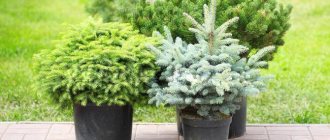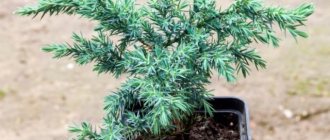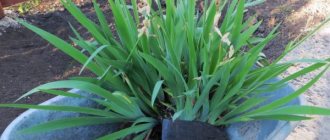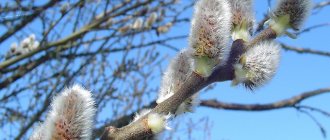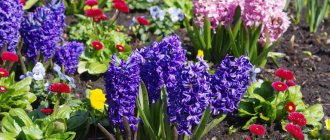This plant is quite whimsical, so we share with you the secrets of where and how to plant hydrangea so that you will definitely enjoy its flowering in the future.
Moisture-loving and light-loving hydrangea is incredibly popular among gardeners. From Latin, its name Hydrangea is translated as “vessel of water.” In relation to hydrangea, a very rare rule for watering is applied: “it is better to over-water than under-water.” The plant blooms from late summer to late autumn and rarely suffers from diseases and pests.
Pink and blue large-leaved hydrangeas have an amazing ability: depending on the composition of the soil, the shade of their inflorescences also differs. Paniculata and ground cover are resistant to frost, and tree-like ones are more compact compared to their relatives and can withstand frosts down to –40°C.
You can buy hydrangea seedlings in a specialized store or prepare them yourself by cuttings. By the way, mid-July is the most favorable time for this procedure, because... the shoots have not yet become woody. Adult bushes are divided into several parts during transplantation.
When purchasing seedlings, check with the seller whether they are adapted to the local climate, otherwise unhardened plants may die
Autumn planting of hydrangeas in central Russia is carried out in early September, in the southern region - until the end of autumn. But remember that only plants with a well-developed root system are suitable for the procedure, because otherwise, the bush will not have time to take root before frost. Young plants are best planted in spring.
In autumn, mainly paniculate and tree hydrangeas are planted. Large-leaved - in mid-May. But in the southern regions of Russia you can plant it in September.
When to plant hydrangea in the fall: optimal timing
In order for the plant to be able to quickly survive stress from changing conditions, to take root and settle down faster, it is necessary to carry out the activity at the right time. When is it better to plant hydrangea in open ground in the fall, in what month? Approximately this should be done in September and October . In this case, there should be 3-4 weeks left before the first frost.
However, our country has different weather and climatic conditions and the time of frost. This needs to be taken into account. Approximate dates for planting hydrangea seedlings in the fall in different regions:
- In the middle zone (Moscow region) - the first half of September;
- In Siberia, the Urals, and the Leningrad region - late August and early September;
- In the South - all October.
Hydrangea planting dates according to the lunar calendar 2021
By the way, some summer residents, when carrying out any gardening procedures, are guided by the cycles of the moon. Thus, you can choose the most accurate dates for planting hydrangeas according to the 2020 Lunar calendar:
- Favorable days: in August - 6, 7, 20, 21, 23, 24, 25, 27, 28, 29, 30;
- in September - 9, 10, 11, 15, 16, 19, 20, 21, 26;
- in October - 6, 7, 8, 21, 22, 23;
- in November - 9, 10, 11, 12, 13, 23, 24, 27, 28.
- in August - 4, 5, 19, 31;
Advice! In autumn, it is recommended to plant only seedlings with a well-developed root system (mainly with a closed root system) in open ground.
But it is better to plant young specimens with weak roots in the spring, otherwise there is a chance that they will not have time to take root and settle down in a new place.
Best time to plant
You can plant hydrangea either in the spring or in the fall. The choice of time for planting hydrangeas will depend on the area - in a cold climate zone, spring planting is more effective - then over the summer the seedlings will be able to take root well, and they will not be afraid of autumn frosts and winter frosts. In spring, you can also plant the weakest, young seedlings. Over the summer they will get stronger and easily survive the winter.
You can plant hydrangea starting in March, as soon as the earth warms up and the night frosts end. At first, to better adapt the plant, you can build a small greenhouse by covering the plants with film. During the daytime, on warm sunny days, the greenhouse can be opened when it is completely warmer, and there is no need to close the seedlings at night.
In warm climates, hydrangea bushes can be planted in the fall - winters there are mild, without severe frosts. Such conditions are not scary for hydrangea, and next spring it will delight you with good growth.
Varieties and types of hydrangea
Now you can find different types and varieties of garden hydrangea, let's consider the most popular:
- Tree hydrangea . The most common type of flower crop in Russia, many varieties are excellent for growing in many regions of our country due to their adaptability to weather and climatic conditions. Tree hydrangea prefers both sunny areas and places with partial shade. Popular varieties of this species: “Anabelle”, “Radiant”, “Hayes Starburst”, “Sterilis”. The photo illustrates the variety:
- Paniculata. Just like tree-like, paniculate hydrangea is very popular and widespread in our country because the climatic conditions are suitable for its cultivation. It is necessary to plant paniculate hydrangea in partial shade: when grown in open sunny areas, the flowers and inflorescences will become smaller. However, planting should not be allowed in complete shade! Popular varieties of this type are “Vanilla Fraze”, “Limelight”, “Phantom”, “Pinky Winky”, “Matilda”, “Grandiflora”.
- Petiole hydrangea . It is also called “climbing”, “curly”, “liana-like”. This type of flower crop is less common in our country than the species mentioned above. The climbing plant can grow many meters, suitable for lovers of climbing vines. Grows and develops well in the shade.
- Large-leaved hydrangea. Distinguished by its beautiful flowers and leaves, this species is planted relatively rarely in our area, because it is heat-loving and requires special growing conditions. If you planted this type of crop, then in the fall you need to cover it very well before the winter cold.
- There is also oakleaf, groundcover hydrangea, Bretschneidera.
Advice! For planting, it is best to choose paniculate and tree-like types of hydrangea, as they are better suited for cultivation in our country.
Selecting a location
Hydrangea is a light-loving flower, so it can be planted in warm regions where the sun predominates most of the time.
Seedlings need to be protected from strong winds and excessive solar activity. At the peak of the heat, tree and paniculate hydrangeas are best protected with slight shading. If there is diffused light above the plant, then these are ideal conditions for development.
Large-leaved hydrangea, planted in a slightly dark place, is characterized by late flowering with a small number of flowers.
It is better to plant hydrangea in the fall on the east side, so that it receives the required amount of light before noon.
How to choose a good hydrangea seedling for planting
The choice of planting material is a responsible matter, because the quality of the seedling determines the survival of the plant in a new place, normal growth, beautiful and lush flowering in the future, as well as life expectancy. However, you can obtain planting material yourself - by cuttings.
Advice! It is best to buy garden hydrangea seedlings in nurseries, garden centers or specialized stores that have good reviews and a reliable reputation.
At points of sale you can find two types of planting material:
- A hydrangea seedling with an open root system (OKS) is cheaper, and it is possible to carefully examine the condition of the root system.
- and with a closed root system (ZKS) - it costs more than the first option, but its survival rate is higher, and it is also more convenient to handle and replant. Ideal for beginner gardeners, and this type of planting material can be planted even in summer.
General rules and tips for choosing a quality hydrangea seedling for planting in the fall:
- The general condition of the planting material is good and healthy. The shoots, bark, and trunk have no damage, signs of disease, or cracks.
- A good seedling should have a developed root system. This is easy to check for planting material with OKS. But if you are interested in the option with ZKS, then you need to carefully remove the plant from the pot - the roots should entwine the earthen ball (if this is not possible, then inspect the drainage holes at the bottom of the container, the roots should be visible from them).
- The root system has no traces of mold, rot, damage, or suspicious growths. The smell of mold emanating from the roots should also alert you (perhaps unscrupulous sellers removed the mold in advance). Also, the roots should be moist, elastic, and not dry. To check this in a seedling with ZKS, you also need to carefully pull it out of the pot with a lump of earth and look.
- The above-ground part should be healthy; the seedling should have 2-3 shoots that grow symmetrically to the trunk. However, if the planting material looks a little crooked and not symmetrical, but other criteria are normal, then you don’t have to be afraid to buy such a specimen: in the future it will be possible to straighten it with the help of pruning.
By the way! If you bought a hydrangea seedling with an open root system (OKS) before planting, then you need to take care of its storage. To do this, plant it in a container with acidic soil. Afterwards water moderately.
But storing a seedling with a closed root system (ZRS) is much easier: you just need to periodically water the plant before planting it in open ground.
Preparing the plant for winter
In order to protect newly planted bushes from freezing, you need to cover it in the center with dry moss 30 centimeters upward. If this is not possible, then sawdust, earth, straw, and tree bark can be used as shelter. In addition, you need to cover the tree trunk soil with mulch and not be afraid to overdo it with a layer. Next, twine is used to tie the bush, wrapped around it with spunbond and covered with spruce or pine branches on top.
As soon as the frosts begin to subside, you need to remove the mulch so that the plant does not rot and put fresh mulch in its place. Since in the first years of life the plant grows green mass, the inflorescences should be cut off.
Hydrangea does not require special care and is quite easy to do in the garden, so it may be worth taking a closer look at it and planting it.
How to plant hydrangea correctly in the fall: main steps
The autumn event can be divided into several key stages:
- Choice of location and soil.
- Preparing the site and planting hole.
- Filling the pit with fertilizers and special soil.
- Preparing a seedling.
- Direct landing.
Let's look at all the steps in more detail.
Step 1: Deciding on a location
Garden hydrangea cannot be called a completely unpretentious plant that will grow freely in any place and on any soil. If you want to see normal growth and lush flowering of the plant, you need to make sure that the flower culture is comfortable in your garden.
The following tips and recommendations will help you choose the most suitable place and soil for planting a seedling in the fall:
- Flower culture loves diffused sunlight: the lighting should be soft, without too bright and scorching sun rays. It is good if sunlight illuminates the plants in the morning and evening, but at noon it is shaded. In bright sun throughout the day, the flowers will quickly fade, flowering will not last long, you will have to water more often, because the evaporation of moisture in the sun will occur faster. Paniculata hydrangea - you need to plant it in partial shade, bright sunlight will negatively affect flowering.
- Tree-like - comfortable in the sun and in partial shade (but in any case, shading is desirable during the hottest and sunniest hours).
- Chereshkovaya - this species prefers shady places.
- Large-leaved - good lighting in the morning and evening, shading in the afternoon.
- Oakleaf, serrated hydrangea - shady places.
Note! In southern regions with hot and scorching rays, plants need to be shaded more. But in more northern areas (Leningrad region, Ural, Siberia, Middle zone) more sun can be allowed.
- Despite the fact that hydrangea is a moisture-loving plant , it cannot be planted in swampy areas, in lowlands , in places where moisture stagnates, or in areas with high groundwater levels.
- You need to choose a place that is sheltered from drafts and winds (especially from the north side), but there is no stagnation of air and normal air circulation.
- A short distance should be maintained if you want to plant the crop next to garden paths. The fact is that when flowering the shoots become heavier and bend. If the bush is too close to the paths, the branches will block the path.
- The plant looks good behind an alpine slide or mixborder.
- Flower crops should not be planted under trees, because competition for nutrients and moisture cannot be avoided.
By the way! When choosing a place for autumn planting of hydrangea, you should take into account favorable and unfavorable proximity to other crops.
Good neighbors: hosta, astilbe, boxwood, mock orange, spirea, lilac.
Bad neighbors: flowers and shrubs with a shallow root system (otherwise they will oppress each other) or simply aggressive plants, for example, loosestrife, ostrich fern, bulbous ryegrass.
The main criteria for soil that is suitable for planting and growing hydrangeas:
- nutritious;
- loose;
- moisture-absorbing;
- slightly acidic (5-6.2 pH).
It is not recommended to plant hydrangea in areas with heavy, clay soil, neutral or alkaline soil.
Note! For the successful cultivation of this flower crop, the correct acidity of the soil is very important: it must be slightly acidic.
On alkaline soil, the plant will suffer from chlorosis. Therefore, under no circumstances apply fertilizers such as wood ash or dolomite flour (they deoxidize the soil).
On neutral soil, the shrub will grow slowly and bloom inconspicuously.
Step 2: Prepare the place
Garden hydrangea has special preferences, so preparing the site and planting hole is the most important step of the entire procedure. You need to do preparatory activities in advance: preferably 4 weeks in advance, or at least 2-3 weeks in advance.
This plant has a superficial root system, so it is very important to prepare not only the hole for planting (in depth), but also the area in width.
You can prepare a place for planting a hydrangea seedling as follows:
- It is necessary to remove debris, stones, weeds along with roots (if any) from the site.
- Then you need to dig up the selected planting site (preferably within a radius of one meter) along with acidic high peat (a bucket of the substance per square meter).
- After digging, you need to loosen and level the area.
Step 3: Prepare the planting hole
Now you need to prepare the landing hole. The optimal depth and width of the hole is 50 centimeters, but it is better to make it 60 cm, because the hole will still be filled with special soil. In this case, the top fertile layer of soil should be put aside in a separate pile: it will still be needed.
By the way! Do you know at what distance it is better to plant hydrangea so that all the bushes feel comfortable? The optimal distance between seedlings when planting is 1-1.5 meters. But if you want to plant a hedge, then the distance between plants is about 0.6-0.7 meters.
After digging a hole, you need to move on to the next preparation step: filling the hole with fertilizers. You can fill the planting hole in the following ways:
- The most effective method: Coniferous litter is placed at the bottom of the hole to acidify the soil.
- Then 7-10 centimeters of ordinary garden soil.
- After this, you need to put 2/3 of the following mixture in the hole: humus or compost (2.5 kg or 1/4 of a regular bucket), the same amount of acidic peat or purchased special soil for crops that love acidic soil, for example, blueberries.
- Now you need to spread mineral fertilizer on top: a handful of Superphosphate.
- You need to prepare the following mixture: high acidic peat (1 part), humus or compost (1 part), ordinary garden soil (1 part).
- Refilling method for heavy, clayey, infertile soil. At the bottom of the hole you need to put pine litter (if there is none, then at least acidic peat).
- Afterwards, the pit is filled 2/3 with the following mixture: acidic high peat (1 part), sand (1 part), humus or compost (2 parts), leaf or turf soil (2 parts).
- The easiest refueling option. Two-thirds of the hole is filled with a mixture of ordinary soil from the garden and acidic high-moor peat (instead of peat, you can buy special acidic soil at a garden center, for example, a soil mixture for growing blueberries).
After filling the planting hole with special soil and fertilizer, you need to water it generously so that the soil settles.
Step 4: Preparing the seedling for planting
Preparing a seedling for autumn planting helps it take root faster in a new place and easily survive adaptation.
If you have a hydrangea seedling with an open root system (OKS), then it can be soaked in a solution of a drug that stimulates root formation, for example, Kornevin, Heteroauxin.
It is even easier to prepare a seedling with a closed root system (CRS): just slightly disturb the surface of the earthen ball so that the roots begin to grow.
Step 5: Properly planting hydrangea in open ground
Autumn planting scheme for hydrangea seedlings with an open root system (OKS):
- A few hours before the event, you need to water the hole.
- Make a small mound of special soil in the center of the hole, for example, a 1:1 mixture of fertile soil from the topsoil and acidic peat (or other acidic soil).
- Place the seedling on the mound, carefully straighten the roots down so that they look evenly in different directions. The roots should not bend upward!
- Fill the hole with the same soil from which you made the mound. The soil must be poured gradually so that voids do not form.
Important! When planting, the root collar should remain at soil level. You cannot bury it, otherwise it may rot.
- Compact the soil with your hand around the seedling.
- Water abundantly (about 3-4 buckets per bush). It is also recommended to water with a portion of Kornevin or Heteroauxin solution so that the seedling takes root faster and more successfully.
Note! Immediately after planting and watering, you need to check the soil level - if the ground has settled, then you need to add more soil to the previous level. It is also recommended to check this after a few days.
to plant hydrangeas with a closed root system (ZRS) according to almost the same scheme. The difference: you don’t need to make a mound of soil and straighten the roots. Just place a ball of earth in the planting hole. If the root collar is too deep, then lift the seedling and add soil.
Soil for hydrangea
Wood sawdust
Garden hydrangea is not picky and can grow in any soil with a good level of fertility. For better flowering, soil with an acidic or neutral reaction is suitable. To oxidize the soil, you can add peat, pine needles, sawdust or the bark of coniferous trees.
The color of large-leaved hydrangea inflorescences depends on the degree of acidity of the soil. By increasing or decreasing the acidity of the soil, you can change the shade to pink or blue.
The plant responds gratefully to soils with good moisture holding capacity. And unlike other garden plantings, it is calm about groundwater that lies close to the surface. It is not for nothing that its second name is hydrangea, so the bushes are watered abundantly, especially on hot days.
If the soil contains a lot of sand, more frequent watering is required. But the presence of a large amount of limestone in the soil can play a bad role, and the plant may not bloom at all.
If the site has poor, depleted soil, then it should be enriched in advance. It is necessary to prepare a special substrate, which is introduced into the planting holes. It can be a mixture of leaf soil, humus, peat and sand. For more nutritional value, nitrogen-containing, phosphorus-containing and potassium fertilizers are also applied.
Preparing a hole for planting hydrangeas
The hole for the seedling is prepared in advance and then filled with a special mixture. For young plants 1–2 years old, you can prepare a small hole measuring 30 by 30 cm. Older plants will require more space. For them you need to make a hole 50 by 50 cm.
Whether a seedling blooms or not depends on many reasons. A tiny twig will need more than one year to grow stems and green mass. And if there is a full-fledged seedling with formed roots, then next year it can please with the first inflorescences. Tree-like and paniculate varieties of hydrangea will be able to bloom immediately. The large-leaved species in central Russia is more capricious and is unlikely to quickly produce buds.
What to do with hydrangea after autumn planting: basic care rules
Caring for a shrub after an autumn event is much easier, but there are a number of steps that must be performed correctly and efficiently for normal survival.
So, what are the rules for caring for garden hydrangea seedlings after planting in open ground in the fall?
- After planting, be sure to mulch the planting site . Mulch will perform 2 functions: it will slow down the evaporation of moisture and protect the young root system from the cold. It is recommended to use acidifying elements as mulching material: pine litter, rotted pine sawdust and bark, or high-moor acidic peat. The optimal layer thickness is 5-7 centimeters.
Important! The mulch should not come into contact with the trunk of the seedling, otherwise it will begin to rot. There should be a distance of about 5-7 cm between them.
- The shrub is moisture-loving, so for effective care the first two weeks after planting you need to water it regularly . The soil should be moderately moist. If it rains often, the number of waterings can be reduced.
- In regions with cold winters, for example, the Middle Zone (Moscow region), Siberia, and the Urals, it is very important to protect and shelter young hydrangea from frost . To do this, you must first remove all remnants of leaves and inflorescences (if any). Then, at the first frost, you need to pour sphagnum moss (about 30 centimeters) into the center of the bush. If it is not possible to use moss, then you can put leaf humus, pine bark, rotted sawdust, and peat.
- Also, at the first frost, you need to add mulch to the tree trunk circle so that its layer is 15-20 cm. In this case, mulch will protect the root system from freezing.
- After this, you need to carefully tie the shoots of the bush with twine so that they are not damaged due to snow, wind, or heavy rain. Then wrap it in burlap, spunbond or spruce branches.
Important! When the frosts end, in the spring you need to immediately remove the cover and mulch to prevent damping off of the bush. Then put a new layer of mulch - about 7-9 cm.
Caring for hydrangea in open ground
Hydrangea is a perennial with special requirements for soil, watering, fertilizing, pruning and covering, and these simply need to be taken into account when properly caring for them after planting.
Features of care after autumn planting
In principle, all care for hydrangea after planting in the fall comes down to watering, if this is, of course, necessary, because autumn means rain, which means there is a high probability of contracting a fungal disease , therefore, as a preventive measure to shed the soil in the hydrangea circle a couple of times light pink solution of potassium permanganate.
By the way! Feeding tree hydrangea with potassium permanganate stimulates the compaction (they will become thicker and stronger) of the bush shoots.
It will be great if you acidify the soil by spilling it a couple of times with a solution of citric acid, vinegar or another acidifier.
If you decide to plant large-leaved hydrangea , then do not forget to cover it very carefully for the winter.
Watering
As for hydrangea, it is better to overwater it than to underfill it, because... This plant is very, very moisture-loving.
If the heat in the summer is 30 degrees, then you need to water the hydrangea every day if possible, pouring 1 bucket of water onto the middle bush. Or at least after 2-3 days, but in this case the portion should be increased to 2-3 buckets, of course, provided that your plant is also mulched.
Top dressing
If you want your hydrangea to always bloom profusely and luxuriantly, it needs regular and good feeding.
Note! The site already has a detailed article on feeding hydrangeas in spring and summer .
In general, the feeding scheme for hydrangea is as follows:
- At the very beginning of growth (awakening) and to gain green mass - mainly nitrogen fertilizers and a little potassium and phosphorus.
- During budding - potassium-phosphorus fertilizers.
- During flowering - again potassium-phosphorus fertilizers.
- After flowering (in autumn) - phosphorus and potassium again.
Advice! If you rarely go to the dacha , then it is optimal to use special complex fertilizers with prolonged action. In other words, in early spring you need to add fertilizer to the hydrangea tree trunk, and the plant will gradually receive nutrition almost throughout the entire season.
There are also special fertilizers for hydrangeas (also suitable for rhododendrons and azaleas).
Acidification
The soil under hydrangeas for their successful cultivation and abundant flowering must always be acidic, which means it must be acidified periodically (once every 2-3 weeks) (otherwise the plant may develop chlorosis).
Here's what you can use to acidify the soil for hydrangeas:
- weakly acidic electrolyte solution (10 ml per 10 liters of water);
- sulfuric acid;
- vinegar (100 grams of 9% vinegar per bucket of water);
- citric acid (20-40 g per 10 liters of water).
Moreover, it is advisable to add iron chelate or iron sulfate (20-30 grams per 10 liters) to the solution.
Garter
If you planted a tree hydrangea, then when the flowers begin to gain strength, so that they are not bent down or broken by rain and wind, the plant should be tied up if possible. Moreover, you can do this very effectively, so that the inflorescences form a kind of tent.
Diseases and pests
As a rule, hydrangea is rarely overcome by diseases and pests, but this also happens, so you should know the most typical problems that arise in the process of growing this wonderful flowering shrub.
If you do not properly prepare the soil for planting hydrangeas, or do not periodically acidify it, then over time it will become too alkaline (due to precipitation and watering), and your favorite hydrangeas will certainly develop chlorosis.
You can determine that hydrangea has chlorosis by the leaves - the leaves become light green, spots appear on them, and they begin to fall off, and the flower ovaries become smaller.
To eliminate chlorosis, it is necessary to take measures to treat the flower, namely, the plant requires an increased amount of iron and an acidifier for its absorption. You, of course, can dig nails or cans into the soil in the old-fashioned way, but this can hardly be called a modern solution to the problem. It would be much better to use iron sulfate or iron chelate. As soon as you apply a solution prepared with one of the fertilizers, the bush will recover quite quickly.
Advice! Do not forget that it is necessary to acidify the soil, for example, using various acids: citric, acetic, sulfuric.
It’s better to prepare a tank mixture: for 10 liters of water you will need 20-40 grams of citric acid and 20-30 grams of iron sulfate .
It happens that you may notice powdery mildew on the leaves of hydrangea. Spraying with a solution of Bordeaux mixture or copper sulfate will help to cope with it.
Control other pests such as aphids, spider mites
, you can use insecticides such as
Fitoverm, Fufanon or Actellik .
Video: diseases and pests of hydrangea
Trimming
You can prune hydrangeas both in the fall and in the spring; there are no fundamental differences. But often preference is given to autumn pruning (just before frost), because in the spring it can be difficult to catch up before the sap begins to flow, and after that this procedure is very undesirable, or rather, even prohibited. In addition, hydrangea bushes often break badly due to snow, so it is better if they go to winter in a more compact form.
However, even if you cut hydrangeas in the fall, then in the spring or summer (before flowering) you should additionally cut out all thin shoots (less than 1 cm thick).
By the way! Read more about pruning hydrangeas (each variety) in the spring article , and in the fall here .
Shelter for the winter
Large-leaved hydrangea is a completely non-frost-resistant shrub, so it simply needs shelter .
Advice for the future! Even in the last month of spring (May) in the middle zone, you cannot completely remove the cover from large-leaved hydrangea, because There may still be frosts, the shoots will freeze, and then the hydrangea will not bloom.
But the tree variety does not need shelter.
Paniculata hydrangea also does not require any shelter. But in order for the plant to overwinter better and not be broken by snow masses (even when cut), it should be lightly tied into a bundle.
Although some gardeners still additionally mulch the paniculata variety for the winter.
Important! Read more about autumn care and preparing hydrangeas for winter in this material .
Thus, if you do not like to bother with covering your plants for the winter, you need a more unpretentious hydrangea, and your choice is a paniculate and tree-like variety.
Advantages and disadvantages of autumn planting
Advantages of planting hydrangea seedlings in autumn:
- With normal rooting, flowering can be seen as early as the next season.
- It is much easier to prepare the place and soil for planting, because the soil is sufficiently warm.
- You don’t have to worry that pests and diseases will encroach on the young shrub.
- You can save time in the spring, because there is already a lot to do this season, and calmly plant flower crops in the fall.
Disadvantages of autumn planting:
- If planted at the wrong time, close to frost, the seedling will not have time to take root, will freeze and die.
- After the procedure, before frost, you need to take a responsible approach to protecting the bush from frost. To do this, you need to spend time on covering and mulching.
- Excessive rainfall and cool weather can cause fungal diseases.
Winter care
You can plant hydrangea in the fall either from cuttings or from fully formed bushes. The main thing is to carefully prepare the bush for the cold weather at this time.
Some varieties have excellent winter hardiness, so mulching is sufficient to preserve them. In the southern regions, gardeners make do with hilling. But in the conditions of the middle and northern zone, hydrangea must be covered or dug up for overwintering in the house. The preparation of measures begins in late October early November.
Young seedlings should be brought into the house, or additionally insulated with something.



